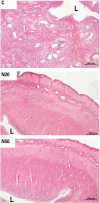Prenatal exposure to nitrate alters uterine morphology and gene expression in adult female F1 generation rats
- PMID: 39876961
- PMCID: PMC11771761
- DOI: 10.20945/2359-4292-2024-0085
Prenatal exposure to nitrate alters uterine morphology and gene expression in adult female F1 generation rats
Abstract
Objective: Nitrate is ubiquitously found in the environment and is one of the main components of nitrogen fertilizers. Previous studies have shown that nitrate disrupts the reproductive system in aquatic animals, but no study has evaluated the impact of nitrate exposure on the uterus in mammals. This study aimed to evaluate the impact of maternal exposure to nitrate during the prenatal period on uterine morphology and gene expression in adult female F1 rats.
Materials and methods: Pregnant Wistar rats were either treated with sodium nitrate 20 mg/L or 50 mg/L dissolved in drinking water from the first day of pregnancy until the birth of the offspring or were left untreated. On postnatal day 90, the uteri of female offspring rats were collected for histological and gene expression analyses. Morphometric analyses of the uterine photomicrographs were performed to determine the thickness of the layers of the uterine wall (endometrium, myometrium, and perimetrium) and the number of endometrial glands.
Results: The highest nitrate dose increased the myometrial thickness of the exposed female rats. Treatment with both nitrate doses reduced the number of endometrial glands compared with no treatment. Additionally, nitrate treatment significantly increased the expression of estrogen receptors and reduced the expression of progesterone receptors in the uterus.
Conclusion: Our results strongly suggest that prenatal exposure to nitrate programs gene expression and alters the uterine morphology in female F1 rats, potentially increasing their susceptibility to developing uterine diseases during adulthood.
Keywords: DOHaD; female rats; nitrate; uterus.
Conflict of interest statement
Disclosure: no potential conflict of interest relevant to this article was reported.
Figures





References
MeSH terms
Substances
LinkOut - more resources
Full Text Sources
